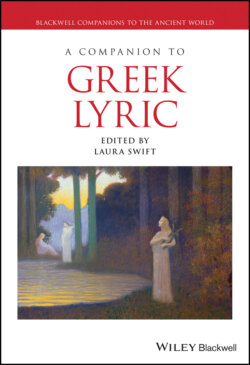Читать книгу A Companion to Greek Lyric - Группа авторов - Страница 61
The Rise of an Aristocracy
ОглавлениеThere is some reflection in the archaeological record of this transition from achieved to ascribed authority and from a ranked, pre-state to a stratified statal society.11 The archaeology of eighth-century Argos reveals no evidence for aristocratic cemeteries, but there is a handful of “warrior graves” belonging to different generations and different settlement nuclei, which is suggestive of basileis presiding over small-scale communities (Hall 2014: 134–135). In Eretria, the 16 wealthy burials belonging to the cemetery by the West Gate, dated ca. 720–680 BC, are more likely to belong to a single family than a ruling class (Bérard 1970; Ducrey 2006), while the apsidal structure (the so-called “Daphnephorion”) excavated within the sanctuary of Apollo Daphnephoros is better appointed but certainly not much more luxurious than its neighbors (Verdan 2013), suggesting the residence of a primus inter pares. Like the earlier monumental building in the Toumba plot at Lefkandi, the Eretria house seems to have been in use for only a short period of time, which might reflect the intergenerational instability of such authoritative regimes (Whitley 1991). Further buildings have been tentatively identified with basileis at Thermon in Aetolia, Nichoria in Messenia, and Koukounaries on Paros.12 Open spaces may have served as venues for meetings of the community as early as the eighth century at sites such as Koukounaries, Dreros, Zagora on Andros, and Emborio on Chios (Hölscher 1999)—although they could also have served ritual or festal functions—but it is not until the second half of the seventh century that the agora of Megara Hyblaea, although left free of development from the earliest years of the settlement, becomes monumentalized (Tréziny 2016). It is also the seventh century that witnesses the earliest buildings with a recognizably public function. At Argos, for example, inscribed and uninscribed lead plaques and weights were found in association with a complex excavated beneath the classical stoa in the Agora (Pariente, Piérart, and Thalmann 1998: 212–213) while a similarly public function has been attributed to a four-room structure with a hearth and clay seals at Koukounaries (Schilardi 1996: 52); a theater-like wooden structure dating to c. 600 BC and found at Metapontum in South Italy has been possibly identified as the seat of the city’s assembly (Hansen and Fischer-Hansen 1994: 65–67).
It is only with the transition to a stratified society that we can talk about the emergence of a true aristocracy. Granted, the values that Homeric heroes articulate—honor, status, prestige goods, and athletic and martial prowess—are precisely those that define the aristocratic ethos in the archaic period (Stein-Hölkeskamp 2015: 189) but, numerically speaking, Homeric basileis are simply not numerous enough to constitute an aristocratic “class.” There are leaders (basileis) and followers (laoi). From the seventh century, however, a nascent aristocratic consciousness is identifiable in an unashamedly elitist terminology that distinguishes between an aristocratic group of insiders, termed variously kaloi (“beautiful” or “fair”), agathoi (“good”), or esthloi (“good” or “brave”) and a much larger group of outsiders or inferiors, designated as kakoi (“ugly” or “bad”) and deiloi (“cowardly” or “wretched”).13 The divisions are especially pronounced in the Theognidea. “It is because I am well disposed to you, Kyrnos,” the poetic voice proclaims, “that I will offer you advice that I myself, as a child, learned from agathoi”(1.27–8). The poet continues: “Do not associate with men who are kakoi, but always hold close to the agathoi; drink and eat with them, sit with them and ingratiate yourself with those whose power is great; for you will learn esthla from those who are esthloi” (1.31–5). In a similar vein, the sixth-century elegiac poet Phocylides of Miletus (fr. 6 W) warns his addressee “to avoid being the debtor of a kakos, lest he cause you grief by demanding repayment at an inopportune time.”
Hans van Wees has argued that the dualistic terminology in the Theognidea should not be seen in terms of class consciousness. Drawing on studies of the Sicilian Mafia, the Calabrian ‘Ndrangheta and Cosa Nostra in the United States, van Wees concludes that Theognis presents “a highly favorable self-image of one section of the elite contrasted with a deeply hostile image of their political rivals,” where terms such as agathos and kakos refer to social standing rather than class affiliation (2000: 60–61). This is largely because he finds no evidence for an aristocratic ideology or for an endangered hereditary aristocracy in the poems of Theognis (2000: 65; cf. Rose 2009: 476). But this is to downplay the importance Theognis attaches to genos (“birth” or “lineage”)—a word that is freighted with indelible hereditary connotations. As he tells Cyrnus, “do not wonder that the genos of the citizens is becoming diluted, because what is esthla is being intermingled with what is kaka” (1.191–192). The analogy that he offers here involves the breeding of thoroughbred horses (ἵππους εὐγενέας: 1.183–4). Furthermore, this sort of elitist terminology is by no means limited to Theognis. For van Wees, the evaluative terms agathoi and kakoi are defined by the faction to which the poetic voice belongs, but that interpretation does not work with Solon’s comment (fr. 34 W) that “it did not please me …that esthloi and kakoi should have an equal share of our country’s rich land.” Here, Solon clearly distinguishes between two groups but proclaims allegiance to neither (cf. fr. 37, where he describes himself as a “boundary marker in no-man’s land”). Alcaeus’ complaint (fr. 130 B Campbell) that he has been dispossessed of his ancestral property or Callinus’ reference (fr. 1 W) to a genos of immortal ancestors, or Tyrtaeus’ exhortation (fr. 10 W) not to disgrace one’s genos do actually imply some sort of hereditary self-validation within elite consciousness.
